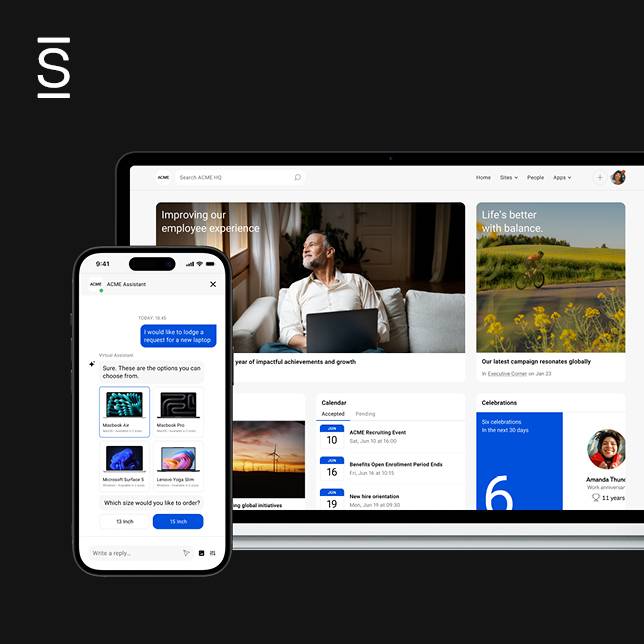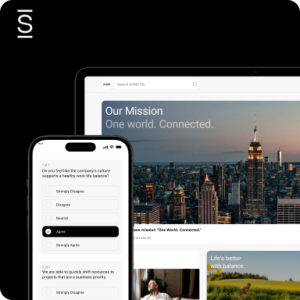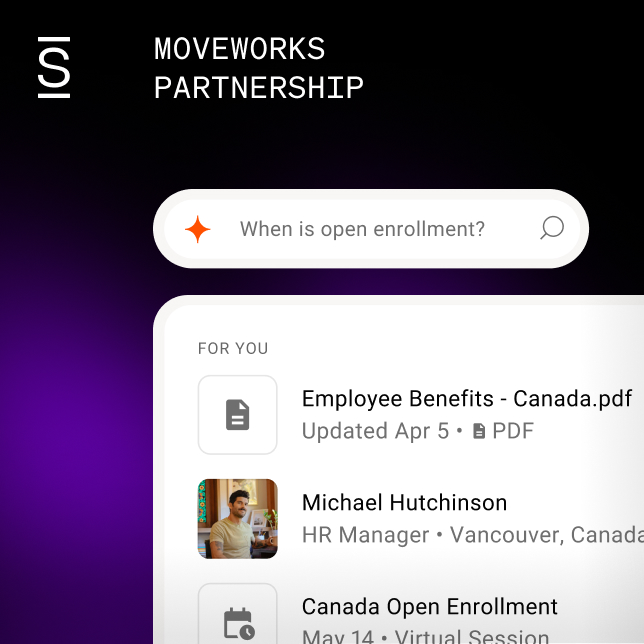Collaboration definition
Collaboration is when people work together to complete a task or achieve a shared goal. It is a strategy that can be implemented in any workplace and within any sector, encouraging equal participation and efficiency in an environment that supports innovation. The act of collaboration involves sharing ideas, knowledge, and resources to achieve better outcomes and solve problems.
Shared workspaces — physical or digital — help team members to communicate, coordinate, and contribute in real time, regardless of location. Whether it’s a meeting room, a project management tool, or an intranet platform, shared workspaces help streamline collaboration by making information accessible, promoting transparency, and keeping everyone aligned.

Exactly what is collaboration?
First, collaboration isn’t a scenario where a team leader or project manager tells people what to do. Collaboration is a strategy, one that can be used in absolutely any workplace and within any sector, where people work together equally and efficiently in an environment that fosters innovation.
The definition of collaboration is when people work together. The act of collaboration involves sharing ideas, knowledge, and resources to achieve better outcomes and solve problems.
The importance of collaboration
Collaboration is viewed as a good thing. It offers the chance for people to communicate with a wide variety of people, and this leads to better ideas through shared experiences and offers broader networking possibilities. Collaboration enables the development, sustenance and growth of key networks.
By incorporating conducive collaboration practices, businesses can foster an environment that boosts the morale and motivation of employees. Collaboration enables employees to feel absorbed and significant in a space that values team participation and shared ideas, thereby contributing to a vibrant work culture.
A collaborative work environment nourishes a positive work culture and within this, people feel able to take on greater challenges. Greater challenges lead to greater productivity and a successful revenue stream.

Types of collaboration
There are a few different types of collaboration. The types, or combination of types, most suitable for your particular work environment will depend entirely on team goals, company mission, and sector.
Team collaboration
Workplace collaboration within teams is perhaps the most common form of collaboration within a company. There is usually a team leader, who is part of a cohesive whole rather than an instructor. This leader ensures open communications and monitors progress. Within the team, all members know what their roles are and how they dovetail with others.
Community collaboration
This typically occurs in the pursuit of shared ideas, or gaining knowledge rather than a team effort towards completing a task. Often, questions and advice are shared within a community group, and the results are relayed to the work or home environment. The idea is that members of the whole team, group or family benefit from the shared information, though they were not part of the initial communications.
Network collaboration
Network collaboration encompasses actions individuals take in their own interests to share or gain knowledge. Social media platforms are a good example of this process, where even if people don’t know each other, they can collaborate via referrals with network members in any part of the world.
Cloud collaboration
Cloud collaboration enables real-time access, reading and editing of an online documents.). With shared access, a collaboratively created and edited document is constantly available in the most up-to-date version.
Video collaboration
This can happen via a number of cloud-based services, like Zoom, Microsoft Teams, or Google Workspace. These services provide a virtual meeting space for two or more participants, be they in the same building or half a world away.
Internal collaboration
Collaboration that takes place internally happens in a discussion forum, or bulletin board format, or, for brief messages, via microblogging, or by way of a wiki to supply and manage information
External collaboration
External collaboration happens when there is information or knowledge sharing between a company and the outside world. For example, between a company brand and social media platforms, where public feedback returns information to the company
Strategic alliance
This is a type of collaboration between two or more companies in pursuit of similar goals, where it is considered prudent to combine resources for optimal outcomes for all companies.
What does collaboration in the workspace mean?
Collaboration in the workspace, always used in a positive context, is defined as two or more people working jointly and successfully on shared projects toward a positive outcome in line with the company mission. Communication, co-operation, mutual assistance, and support, plus the development of shared ideas, all form part of a collaborative culture.
A collaborative situation implies openness, alliance, and unity without conflict. A collaborative force in the workplace engenders a healthy employee experience.
Benefits of collaboration
Many organizations are rethinking how teams connect and work together, but its true impact is only felt when employees are fully engaged. The following benefits show how fostering seamless, connected collaboration can drive real, measurable value across your organization:
Cohesion
Collaboration fosters cohesion in the workspace via quality communications, interactions and teamwork. Employees have the chance to develop and grow, and this is a positive for the company.
Increases creativity and innovation
Open internal communications and idea sharing increase creativity and innovation. Different knowledge and opinions can lead to a number of small ideas becoming one big idea.
Sense of belonging
A collaborative work environment offers more chances for employees to feel seen and heard, be recognized and rewarded, and maintain loyalty.
Simplifies problem solving
Collaboration simplifies problem solving by bringing together diverse perspectives and knowledge, distributing the workload, fostering creativity, improving decision-making, and enhancing communication. This enables the team to identify and address the root cause of the problem, generate innovative solutions, and achieve better outcomes.
Environment open to change
Free-flowing communications and collaboration creates an environment with increased potential for change.
Positive employee experience
A workplace that fosters collaboration over competition offers a more positive employee experience, resulting in a better environment and culture.
Diminished vertical hierarchy barrier
Vertical hierarchy becomes less of a barrier to communications in a collaborative situation where open communication and equality are promoted.
Increased efficiency
Meetings are more efficient as effective communications make sharing, development, and follow-up easier.
Attract top talent
Top talent will be attracted to a company where culture is upheld by a collaborative workforce.
Higher employee engagement
Collaborative processes promote healthy employee engagement, which leads to a better work-life balance, a stronger wellbeing, and increased employee retention.
Collaboration problems
Although most aspects of a collaborative environment are positive, challenges do exist. Some of these challenges are:
- Conflicting schedules
- Communication breakdowns
- Differing work styles
- Poor team leadership
- Lack of transparency within the team
- Absence of clear goals
- Inadequate feedback
- Negative employee mindset
- Cross-department silo mentality
- Lack of employee compliance
- Diminished clarity from too much input
- Global time differences.
Tips for effective collaboration in the workspace
- Develop an environment of trust and transparency throughout the team.
- Set and maintain clear goals and deadlines so everyone on the team can work towards the same objective. If goals and deadlines are defined collaboratively, so much the better.
- Establish ground rules from the start and make expectations clear, enabling collaborators to navigate within a defined framework.
- Foster diversity within teams because each person brings unique talent, skills and knowledge.
- Encourage team members to be themselves and provide team support for those less outgoing. A sense of equality promotes blue sky thinking.
- Plan, manage and monitor, or brainstorming sessions risk becoming free-for-alls.
- Be accessible, make it easy to ask for help, and encourage feedback.
- Groups must be assembled with care to give good balance of character, or you could end up with a team entirely made up of introverts.
- Similarly, while friendly competition is to be encouraged, choose people who complement one other rather than compete because this will reduce conflict.
- Promote flexibility as this encourages people to adapt to the styles of their teammates.
- Use digital technology to facilitate communications and keep participants on the same page. Shared platforms work best.
- Make sure team members have the right resources and tools for the job.
How can collaboration be fostered in the workplace?
While technology has made communication between and across teams much easier, uniting teams with different priorities and making them work together towards a common goal is easier said than done. Therefore, here are a few strategies to foster collaboration in the workplace:
Lead by example
Trust and transparency play an important role in fostering a collaborative environment, and these can be developed via personal contact and effective communication. Once this is established, employees will feel a valued part of a larger vision.
Set clear goals
While clear goals are the lifeblood of effective collaboration, flexibility opens up opportunities for creative sharing.
Optimal tools and training
Provide tools and technology that help your employees collaborate better, such as with a modern intranet.
Discover our guide for the best intranet platforms for 2025
Promote and encourage collaboration
Encourage collaborative teamwork as an integral part of company operations to strengthen and develop a cohesive company culture.
Rewards and recognition
Recognize quality performance and reward accordingly, and people will be happy to progress to greater challenges.
Ongoing monitoring
Consistently monitor a blossoming collaborative culture for weak points, and correct where necessary.
Collaboration examples
The Leukaemia and Lymphoma Society
The LLS is a global leader in the fight against leukaemia and the voice for patients needing affordable, quality, coordinated care.
This LLS case study shows how Simpplr provided LLS staff with real-time access to people, news, information and resources, at any time or in any place.
Simpplr replaced the LLS’s homegrown intranet which was outdated and difficult to navigate. They provided staff with quick and easy methods to access news and information, and lessened the email overload. This enabled seamless cross-collaboration, information and idea sharing, and positive communications around each other’s successes.
WestEd
WestEd is a non-partisan, non-profit R&D and service agency, working with education and other communities across the USA, and globally, to improve education for children and adults.
Here, the WestEd case study tells us how Simpplr replaced an outdated intranet which made communication difficult, and hampered the efficient creation, distribution and organization of content. A globally distributed workforce was reconnected via improved communications, and collaboration and work methods were transformed.
Quantcast
In the age of AI, Quantcast assists brand growth, and has built ‘Q’, internet world leader in AI-driven consumer behavior platforms.
We learn from this Quantcast case study how they experienced tremendous growth and quickly became vastly distributed with scattered resources. Communications became inadequate for clear company messaging. Simpplr created a digital hub to enable employees to work more efficiently and collaboratively.
Putting it all together
Collaboration is a valuable strategy to boost and embed positive teamwork, driven by effective communication within a company. It greatly enhances the employee experience and employee engagement and can be implemented in any business, across any sector, whether the workplace is on-site or hybrid. Collaborating on an equal footing with colleagues stimulates employee engagement, and this has a decisive knock-on effect on engagement, productivity, and loyalty. A good collaboration strategy embraces a workplace diversity of talent, skills, and knowledge.
In the highly competitive arena of talent retention, the importance of collaboration in the workplace is key.

Watch a 5-minute demo
See how the Simpplr employee experience platform connects, engages and empowers your workforce.
- #1 Leader in the Gartner Magic Quadrant™
- 90%+ Employee adoption rate










